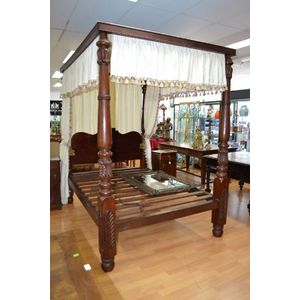19th Century Australian Colonial Cedar Four Poster Bed
You must be a subscriber, and be logged in to view price and dealer details.
Subscribe Now to view actual auction price for this item
When you subscribe, you have the option of setting the currency in which to display prices to $Au, $US, $NZ or Stg.
- Back Boards - As the name implies, the boards that back a piece of cabinet furniture such as a chest of drawers. The backing timber is usually of cheaper material like pine (often called 'deal' by the British trade), though in early Australian colonial days, red cedar was also used to back a piece. As cedar became scarcer during the later 19th century, craftsmen turned to kauri pine.
On early furniture, made before the first half of the 19th century, the backboards were often chamfered at the edges and the wide boards slotted into grooves in a supporting central frame. In later furniture, the backboards were generally nailed or screwed into rebates cut directly into the carcase and the boards became much thinner and narrower.
From about the first world war plywood was frequently used for cheaper pieces.
Backboards are one important way of judging the age of a piece of furniture. - Turning - Any part of a piece of furniture that has been turned and shaped with chisels on a lathe. Turned sections include legs, columns, feet, finials, pedestals, stretchers, spindles etc. There have been many varieties and fashions over the centuries: baluster, melon, barley-sugar, bobbin, cotton-reel, rope-twist, and so on. Split turning implies a turned section that has been cut in half lengthwise and applied to a cabinet front as a false decorative support.
This item has been included into following indexes:
Visually similar items

An impressive late 19th early 20th century Sri Lankan Colonial four poster canopy bed, the folding canopy supported by tapered faceted supports, the bed head with scroll molded crest and back 175 cm width, 213 cm long, 45 cm (from floor to base)

A rectangular wall mirror in naturalistic branch carved frame, Continental, 19th century, 98 x 65 cm

Edwardian umbrella stand, 77 cm wide, 81 cm high approx.

Antique 19th century French prayer chair
